
Enterprise Resource Planning Solutions for Modern Businesses
In today’s fast-paced and highly competitive business landscape, organizations constantly seek ways to streamline operations, enhance efficiency, and gain a competitive edge. One of the most powerful tools for achieving these goals is Enterprise Resource Planning (ERP) software. This comprehensive solution integrates various business processes and functions, providing a centralized platform for managing and optimizing organizational resources.
What is Enterprise Resource Planning?
Enterprise Resource Planning (ERP) is a business management software that integrates and automates core organizational processes, such as finance, accounting, procurement, supply chain, inventory management, human resources, and customer relationship management. Enterprise Resource Planning systems provide a unified platform for managing and accessing real-time data across the organization, enabling better decision-making, collaboration, and operational efficiency.
Key Components of Enterprise Resource Planning
Financial Management:
This module handles all aspects of accounting, financial reporting, budgeting, and cash flow management within the organization. It ensures accurate financial records and facilitates decision-making by providing insights into the company’s financial health.
Supply Chain Management:
This module manages the flow of products and services from procurement to distribution. It covers supplier relationship management, logistics management, inventory control, and procurement process optimization.
Human Resources:
The HR module manages employee-related processes and data. It encompasses employee records management, payroll processing, recruitment and onboarding, training and development, and performance management and appraisal systems.
Customer Relationship Management (CRM):
CRM modules focus on managing interactions with current and potential customers. They store customer data, facilitate sales processes, track customer interactions, and support customer service activities to enhance customer satisfaction and loyalty.
Manufacturing and Operations:
This module supports the planning and execution of manufacturing activities and procedures. It incorporates production planning, scheduling, inventory management, quality control, and shop floor management to ensure productive and economical manufacturing processes.
Business Intelligence and Analytics:
The BI and Analytics module provides tools for reporting, data analysis, and decision support. It enables organizations to gather, analyze, and interpret data from various sources to gain insights into business performance, trends, and opportunities, thus supporting informed decision-making and strategic planning.
Benefits of Enterprise Resource Planning
Improved Efficiency:
ERP systems automate tedious operations and integrate many functions to optimize corporate processes. As a result, work is completed more quickly, less physical labor is required, and overall productivity is increased.
Enhanced Collaboration:
ERP offers a single platform for data exchange and access, which promotes improved departmental communication and collaboration. Teams can collaborate more successfully, exchange information easily, and come to conclusions.
Better Decision-Making:
With real-time access to accurate data and comprehensive reporting tools, ERP systems enable informed decision-making at all organizational levels. Leaders can analyze performance metrics, identify trends, and forecast future outcomes more effectively, leading to better strategic decisions.
Cost Savings:
ERP systems help organizations save costs in various areas, such as inventory management, procurement, and resource allocation, by optimizing processes, reducing manual errors, and minimizing redundant activities. Moreover, improved financial data and operations visibility allow for better budgeting and resource utilization.
Increased Customer Satisfaction:
ERP systems with integrated CRM modules enable organizations to better understand and serve their customers. By centralizing customer data, tracking interactions, and providing personalized services, companies can enhance customer satisfaction, loyalty, and retention.
Regulatory Compliance:
ERP systems assist businesses in ensuring that the industry follows the rules, guides regulatory compliance, and lowers the risk of fines or penalties by enforcing uniform processes, keeping accurate data, and offering audit trails.
Scalability and Flexibility:
ERP systems are made to grow with an organization and adjust to its changing needs. They can grow with the company to accommodate more users, transaction volumes, and new features. Because of their scalability and versatility, ERP systems may be used by companies of various sizes, from start-ups to major corporations.
Competitive Advantage:
Organizations can obtain a competitive edge by installing an ERP system, which improves decision-making, customer service, and operational efficiency. When processes are improved, and resources are used efficiently, businesses can adapt to changes in the market, grow faster, and stay one step ahead of their competitors.
Challenges of Implementing Enterprise Resource Planning
Complexity of Implementation:
Implementing ERP is intricate and time-consuming; it entails integrating many modules, transferring data, and tailoring the system to the company’s needs. It takes skill, coordination, and careful planning to manage this complexity.
Cost Overruns:
ERP implementation projects often incur higher costs than initially estimated. Expenses may escalate due to customization, data migration, training, and unforeseen technical issues. Organizations must budget carefully and monitor expenses throughout implementation to avoid cost overruns.
Resistance to Change:
ERP implementation often requires changes to existing business processes, workflows, and organizational structures. Employees may resist these changes due to fear of job insecurity, loss of autonomy, or unfamiliarity with the new system. Overcoming resistance to change requires effective communication, training, and change management strategies.
Data Migration Challenges:
Migrating data from legacy systems to the new ERP platform can be difficult due to data discrepancies, data quality problems, and compatibility concerns. The success of the ERP implementation depends on ensuring accurate and comprehensive data migration.
Integration with Existing Systems:
Numerous businesses already have various apps and systems, including inventory management, accounting, and CRM software. Integrating these systems with the new ERP system may be difficult, and middleware or bespoke development may be needed.
Lack of ERP Expertise:
Specialized knowledge and expertise are needed to implement and manage an ERP system. Nevertheless, many businesses need more internal resources with the required training and expertise. This may result in delays, mistakes, and inefficiencies in the implementation process.
Vendor Reliability:
Choosing the right ERP vendor is critical for the success of the implementation. Organizations must evaluate vendors based on reputation, reliability, support services, and product roadmap. Selecting an unreliable or inexperienced vendor can result in project delays, technical issues, and additional costs.
Scalability and Flexibility:
ERP systems must be adaptable and scalable to handle future expansion and modifications in business needs. However, certain ERP systems might need to be more scalable or hard to modify, limiting the organization’s capacity to use them in the long run.
User Training and Adoption:
Training and support are necessary to guarantee user acceptance and optimize the ERP system’s advantages. However, insufficient or poorly implemented training programs can cause errors, low productivity, and user discontent.
Security and Compliance:
ERP systems are popular targets for data breaches and cyberattacks because they store critical corporate data. Because of the system’s complexity and the constantly changing nature of cybersecurity threats, ensuring the ERP system’s security and compliance with data protection standards can take time and effort.
Trends in Enterprise Resource Planning
Several trends are shaping the landscape of Enterprise Resource Planning (ERP) systems, influencing how organizations implement and utilize these platforms to drive efficiency and innovation. Here are some key trends in ERP:
Cloud-Based ERP:
The adoption of cloud-based ERP solutions continues to rise as organizations seek flexibility, scalability, and cost-effectiveness. Cloud ERP offers benefits such as easy accessibility, automatic updates, and reduced infrastructure costs compared to traditional on-premises ERP systems.
Mobile ERP:
With the proliferation of mobile devices, there’s a growing demand for ERP systems that provide mobile access to critical business data and functionalities. Mobile ERP applications enable employees to access information, perform tasks, and make decisions on the go, improving productivity and responsiveness.
Integration with Emerging Technologies:
The Internet of Things (IoT), blockchain, machine learning, and artificial intelligence (AI) are among the cutting-edge technologies ERP suppliers progressively incorporate into their systems. Supply chain visibility, automation, real-time monitoring, and predictive analytics are some areas where these technologies improve ERP capabilities.
Focus on User Experience (UX):
Modern ERP systems prioritize user experience, offering intuitive interfaces, personalized dashboards, and role-based access to information. User-centric design improves user adoption and productivity while reducing training time and support costs.
Industry-Specific Solutions:
ERP vendors are developing industry-specific solutions tailored to various sectors’ unique needs and regulations, such as manufacturing, healthcare, retail, and professional services. Industry-specific ERP solutions offer pre-configured functionalities and compliance features, accelerating implementation and providing greater value to organizations.
Hybrid ERP Deployments:
Many businesses choose to implement hybrid ERP systems, combining on-premises and cloud-based solutions. With hybrid deployments, businesses can use the cloud’s scalability and accessibility for various tasks while keeping sensitive data on-site.
Focus on Data Analytics:
Data analytics capabilities are becoming increasingly important in ERP systems. They enable organizations to derive actionable insights from their data to drive decision-making and strategic planning. Advanced analytics tools embedded within ERP platforms offer features such as predictive modeling, data visualization, and self-service analytics.
Emphasis on Security and Compliance:
The increasing risk of cyberattacks and data breaches is prompting ERP vendors to improve security and compliance features on their platforms. Strong data encryption, role-based access controls, audit trails, and adherence to industry rules like HIPAA and GDPR are all part of this.
Subscription-Based Pricing Models:
Many ERP vendors are shifting towards subscription-based pricing models, offering flexible pricing options based on usage, number of users, or specific functionalities. Subscription-based models lower upfront costs, provide predictable expenses, and allow organizations to scale their ERP investments according to their needs.
Ecosystem Integration:
ERP systems are becoming more and more connected with other corporate applications and ecosystems, including business intelligence (BI) tools, supply chain management (SCM), human capital management (HCM), and customer relationship management (CRM). Data synchronization, process automation, and a single view of corporate activities across many functions are made possible via seamless integration.
Example Of Enterprise Resource Planning Software
SAP ERP
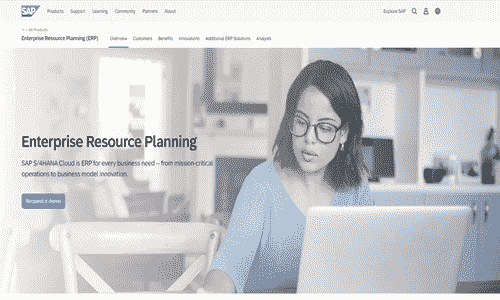
SAP ERP is a whole business software suite that aims to integrate and optimize key company operations for various sectors. It has modules for customer relationship management, supply chain management, human resources, and finance management, among others.
Pros:
Extensive functionality, scalability, robust reporting and analytics, global support, and integration with other SAP solutions.
Cons:
High implementation and maintenance costs, complex customization, and a steep learning curve.
Used for:
Large enterprises and multinational corporations across various industries.
Pricing Package:
Pricing for SAP ERP varies according to the modules chosen, deployment choices, and user count. It is usually given upon request.
Oracle ERP Cloud
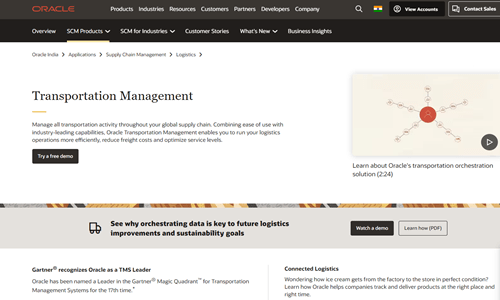
Oracle ERP Cloud, a cloud-based ERP solution, offers an extensive array of apps for finance, procurement, project management, supply chain management, and human resource management. It provides contemporary features like automation and AI-powered analytics.
Pros:
Scalability, flexibility, built-in AI and machine learning capabilities, regular updates and enhancements, and global compliance.
Cons:
The complexity of implementation, potential integration challenges with legacy systems, and subscription-based pricing model.
Used for:
Medium to large enterprises seeking a modern, cloud-based ERP solution.
Pricing Package:
Oracle ERP Cloud pricing varies depending on the modules selected, the number of users, and the subscription duration. Pricing details are available upon request.
Microsoft Dynamics 365
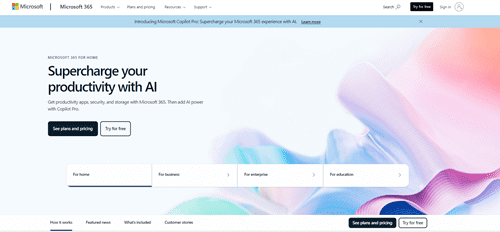
ERP and CRM features are included in the cloud-based business application suite Microsoft Dynamics 365. With integrations for Microsoft Office 365 and Power Platform, it provides modules for customer care, sales, marketing, operations, and finance and operations, among other areas.
Pros:
Seamless integration with Microsoft productivity tools, flexible deployment options (cloud or on-premises), user-friendly interface, and scalability.
Cons:
Compared to other ERP solutions, limited industry-specific functionality may require additional customization for complex business processes.
Used for:
Small to large enterprises across various industries, particularly those already using Microsoft products.
Pricing Package:
The cost of Microsoft Dynamics 365 varies according to the apps chosen and the deployment model (on-premises or cloud). Details about prices can be obtained upon request.
Infor ERP
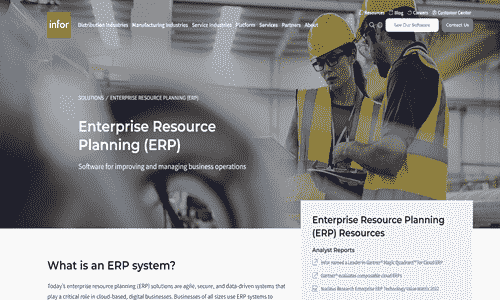
Infor ERP offers a range of ERP solutions tailored to the particular requirements of different industries, such as manufacturing, distribution, healthcare, and services. It provides modules for operations in manufacturing, supply chain management, finance, human resources, and other areas.
Pros:
Industry-specific functionality, flexible deployment options (cloud or on-premises), user-friendly interface, built-in analytics, and business intelligence.
Cons:
Limited scalability for some industry editions may require additional modules for comprehensive functionality, and varying levels of support may be required depending on the region.
Used for:
Medium to large manufacturing, distribution, healthcare, and services enterprises.
Pricing Package:
ERP pricing varies based on the selected edition, modules, and deployment model. Pricing details are available upon request.
NetSuite ERP
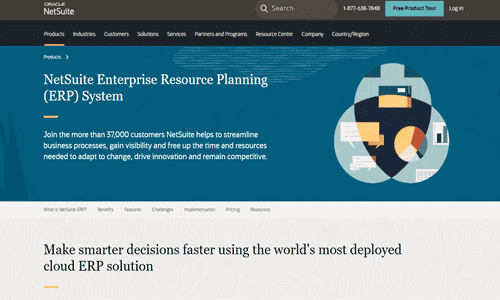
The cloud-based ERP system NetSuite ERP provides an extensive array of applications for financial administration, order management, inventory control, supply chain management, and human capital management. It is intended to simplify processes and offer instantaneous insight into the company’s functioning.
Pros:
Fully integrated suite of applications, scalability, rapid deployment, customizable workflows, global support, and compliance.
Cons:
Limited customization options compared to on-premises ERP systems, potential dependency on internet connectivity for access.
Used for:
Small to medium-sized enterprises across various industries, particularly those seeking a cloud-based ERP solution.
Pricing Package:
The cost of NetSuite ERP is determined by several variables, including the number of users, modules chosen, and extra services needed. The pricing is subscription-based. Details about prices can be obtained upon request.
Future Outlook of Enterprise Resource Planning
The future of Enterprise Resource Planning is closely tied to technological advancements and evolving business needs. As organizations strive for greater efficiency, agility, and data-driven decision-making, ERP systems will continue to evolve and incorporate emerging technologies. Some potential developments include:
Increased Adoption of Cloud-based and SaaS ERP:
Cloud-based and Software-as-a-Service (SaaS) ERP solutions will become more prevalent, offering scalability, reduced IT overhead, and faster implementation times.
Integration with Artificial Intelligence (AI) and Machine Learning (ML):
AI and ML capabilities will be further integrated into ERP systems, enabling predictive analytics, automated decision-making, and intelligent process optimization.
Incorporation of Internet of Things (IoT) and Edge Computing:
ERP systems will leverage IoT and edge computing technologies to capture and analyze real-time data from connected devices and sensors, enabling more efficient operations and predictive maintenance.
Enhanced User Experience and Augmented Analytics:
ERP systems will continue to improve user experience through intuitive interfaces, augmented analytics, and natural language processing capabilities, making data analysis and decision-making more accessible.
Increased Focus on Cybersecurity and Data Privacy:
As cyber threats evolve, ERP vendors will prioritize robust security measures, data encryption, and compliance with data privacy regulations to protect sensitive organizational data.
Implementation Strategies for Enterprise Resource Planning
Top-Down Leadership:
Strong leadership and top management support are crucial for an ERP implementation’s success. Executives should communicate the project’s importance, allocate resources effectively, and champion the initiative throughout the organization.
Cross-Functional Team:
Establish a cross-functional implementation team comprising representatives from various departments and functions within the organization. This team should have a mix of technical expertise, business knowledge, and project management skills to ensure all implementation aspects are addressed.
Comprehensive Planning:
Develop a detailed project plan outlining the objectives, scope, timelines, resources, and milestones for the ERP implementation. Identify potential risks and mitigation strategies and allocate responsibilities to team members accordingly.
Business Process Analysis:
Analyze current business processes in-depth to find inefficiencies, bottlenecks, and potential improvement areas. Find out how the ERP system may improve operations, expedite procedures, and support corporate objectives.
Customization vs. Standardization:
Strike a balance between customizing the ERP system to meet specific business requirements and leveraging standard functionalities to minimize complexity and ensure future scalability. Avoid excessive customization, leading to higher costs and longer implementation timelines.
Data Migration and Cleansing:
Create and implement a plan for migrating data from legacy systems to the new ERP platform. Clean and validate the data after implementation to assure accuracy, consistency, and completeness and reduce the possibility of errors and data conflicts.
Training and Change Management:
Give end users thorough instructions on how to operate the ERP system. Create change management plans to deal with reluctance to change, encourage user acceptance, and guarantee a seamless switchover to the new system.
Phased Implementation:
Consider adopting a phased implementation approach, where the ERP system is deployed incrementally across different departments or business units. This allows for better risk management, testing, and user feedback, reducing the impact of potential disruptions.
Continuous Improvement:
Implementing ERP is a continuous process of improvement rather than a one-time event. Provide systems for tracking system performance, getting user input, and resolving problems or requests for enhancements after the system is implemented.
Post-Implementation Support:
Provide adequate post-implementation support to address technical issues, user inquiries, and system optimization needs. Establish a helpdesk or support team to troubleshoot problems and ensure the ERP system continues to meet evolving business requirements.
Integration of Enterprise Resource Planning with Other Systems
Application Programming Interfaces (APIs):
Many ERP vendors provide APIs that allow third-party applications to interact with the ERP system. Application Programming Interfaces(APIs) enable seamless data exchange and integration between ERP and other systems such as Customer Relationship Management (CRM), Business Intelligence (BI), e-commerce platforms, and supply chain management systems.
Middleware Solutions:
Middleware solutions are intermediaries between different systems, facilitating communication and data exchange. Platforms such as enterprise service buses (ESBs) and integration platforms as a service (iPaaS) enable organizations to connect ERP with disparate systems, synchronize data in real-time, and automate business processes.
Custom Integrations:
Organizations may develop custom integrations using programming languages, development frameworks, and integration tools. Custom integrations allow for greater flexibility and customization to meet specific business requirements. However, they require expertise in software development, which may entail higher development costs and longer implementation timelines.
Pre-Built Connectors:
Certain ERP suppliers provide pre-built connectors or integration adapters for well-known third-party applications. These connectors streamline integration by offering pre-built interface features for widely used systems like payment gateways, e-commerce platforms, and CRM.
Data Warehousing and ETL (Extract, Transform, Load) Tools:
Data warehousing and ETL tools can extract data from ERP and other systems, transform it into a common format, and load it into a centralized data warehouse or data lake. This approach enables organizations to perform advanced analytics, reporting, and business intelligence across integrated data sources.
Service-Oriented Architecture (SOA):
SOA concepts can be used to design modular, loosely linked systems that provide services for interaction and integration. Organizations can develop reusable services for ERP tasks using a service-oriented architecture and integrate these services with other systems using common protocols like SOAP or RESTful web services.
Real-Time Integration:
Real-time integration ensures that data is synchronized and updated across systems in near real-time, enabling timely decision-making and reducing the risk of data inconsistencies. Integration of real-time techniques such as message queuing, event-driven architecture, and change data capture (CDC) are commonly used to synchronize seamless data.
Master Data Management (MDM):
Master data management solutions help organizations establish a single, authoritative source of master data across the enterprise. By integrating ERP with MDM systems, organizations can ensure consistency, accuracy, and integrity of master data such as customer, product, and vendor information across multiple systems and business processes.
Training and Change Management in Enterprise Resource Planning
Understanding ERP Systems:
- Begin by educating employees about ERP systems and how they function.
- Explain the benefits of implementing ERP, such as streamlined processes, data centralization, and improved decision-making.
Assessing Organizational Needs:
- Evaluate the organization’s present systems and procedures in great detail.
- Identify areas where ERP can bring the most value and address existing pain points.
Creating a Change Management Plan:
- Create a thorough change management plan incorporating risk mitigation techniques, stakeholder involvement, and well-defined communication plans.
- Anticipate resistance to change and proactively address it through training and support mechanisms.
Customized Training Programs:
- Design tailored training programs based on employees’ roles and responsibilities within the organization.
- Offer hands-on training sessions that simulate real-world scenarios to help users understand how to navigate the ERP system effectively.
Training Delivery Methods:
- Utilize various training delivery methods, including in-person workshops, online courses, video tutorials, and job aids.
- Provide flexibility in training schedules to accommodate employees’ availability and learning preferences.
Continuous Learning and Support:
- Establish a support system, such as help desks or online forums, where employees can seek assistance and troubleshoot issues as they arise.
- Offer refresher courses and advanced training sessions to ensure employees stay updated on the latest features and functionalities of the ERP system.
Monitoring and Evaluation:
- Establish systems to monitor the training programs’ efficacy and pinpoint areas needing development.
- Ask for employee input to determine their satisfaction with the training and what needs more.
Leadership and Champions:
- Engage organizational leaders as champions of the ERP implementation process to demonstrate their commitment and support.
- To emphasize the significance of ERP implementation, encourage executives to set a good example and actively participate in training sessions.
Celebrating Milestones:
- Acknowledge and celebrate milestones achieved throughout the ERP implementation process, such as successful system Go-Live dates or significant process improvements.
- Employee efforts and contributions to the ERP project’s success should be acknowledged and appreciated.
Continuous Improvement:
- Promote employee feedback and use their observations to enhance training programs and the ERP experience overall. This will support the development of an ongoing culture of improvement.
- Keep up with new ERP trends and technology developments and incorporate pertinent updates into ongoing training programs.
Maintenance and Upgrades of Enterprise Resource Planning Systems
Regular System Maintenance:
- Schedule routine maintenance tasks to ensure the ERP system runs smoothly and efficiently.
- Conduct database optimization, system backups, and performance tuning to prevent slowdowns or system failures.
Patch Management:
- Keep up with the most recent patches and upgrades the ERP provider has provided to fix bugs and security holes.
- Develop a patch management strategy to test and deploy patches in a controlled environment to minimize disruptions to business operations.
Data Management:
- Implement data governance practices to maintain data integrity and quality within the ERP system.
- Regularly clean up outdated or redundant data to optimize system performance and prevent corruption.
User Support and Training:
- Provide ongoing user support to address user queries, troubleshoot issues, and resolve system errors.
- Offer refresher training sessions to ensure users are familiar with new features and functionalities introduced through system upgrades.
Vendor Relationship Management:
- Stay current on future releases, product roadmaps, and support services, and maintain a solid rapport with the ERP vendor.
- Engage with the vendor’s support team to escalate critical issues and request assistance with complex technical challenges.
Testing and Quality Assurance:
- Develop comprehensive test plans to validate system upgrades and customizations before production deployment.
- Perform thorough regression testing to ensure existing system functionalities remain intact after upgrades.
Change Management:
- Notify stakeholders and end users well before impending system improvements to manage expectations and reduce resistance to change.
- Provide training and support materials to assist users in adjusting to new features or workflows brought about by system updates.
Performance Monitoring:
- Implement monitoring tools to track system performance metrics such as response times, resource utilization, and user activity.
- Proactively identify and address performance bottlenecks to maintain optimal system performance and user experience.
Backup and Disaster Recovery:
- Establish reliable backup and disaster recovery methods to protect important data and guarantee company continuity during system failures or loss.
- Test backup and recovery procedures frequently to ensure their efficacy and spot any flaws.
Compliance and Security:
- Maintain compliance with industry rules and security, privacy, and financial reporting guidelines.
- Conduct frequent security audits and vulnerability assessments to detect and reduce possible security threats in the ERP system.
Cost Analysis and ROI in Enterprise Resource Planning
Initial Investment:
- Calculate the upfront costs of purchasing and implementing the ERP system, including software licenses, hardware infrastructure, and consulting services.
- Consider one-time expenses such as data migration, customization, and training.
Ongoing Costs:
- Identify recurring costs such as software maintenance fees, technical support contracts, and system upgrades.
- Factor in expenses related to system administration, user training, and additional modules or integrations.
Cost Savings:
- Evaluate potential cost savings achieved through process optimization, automation, and improved resource allocation facilitated by the ERP system.
- Estimate reductions in labor costs, inventory holding costs, and overhead expenses resulting from streamlined operations and better decision-making capabilities.
Revenue Enhancement:
- Assess ERP’s impact on revenue generation through increased sales, improved customer satisfaction, and faster order fulfillment.
- Quantify the value of new business opportunities enabled by the ERP system, such as entering new markets or launching innovative products and services.
Productivity Gains:
- Measure improvements in employee productivity and efficiency resulting from the automation of repetitive tasks, centralized data access, and real-time reporting capabilities.
- Estimate the time savings achieved by employees in various departments, such as finance, procurement, and manufacturing.
Risk Mitigation:
- Consider the value of risk reduction associated with improved compliance, regulatory adherence, and data security provided by the ERP system.
- Quantify the potential cost savings from avoiding penalties, fines, or legal liabilities due to non-compliance or data breaches.
Intangible Benefits:
- Recognize intangible benefits such as enhanced decision-making, strategic alignment, and organizational agility facilitated by the ERP system.
- While challenging to quantify, these benefits contribute to overall ROI by driving long-term value and competitive advantage.
ROI Calculation:
- Calculate the ROI of ERP implementation by comparing the total benefits accrued over a specific period with the total costs incurred.
- Express ROI as a percentage or ratio, where ROI = (Net Benefits / Total Costs) * 100%.
Periodic Evaluation:
- Conduct periodic reviews to assess the actual performance of the ERP system against the projected ROI.
- Adjust ROI calculations based on updated cost and benefit estimates and identify opportunities for further optimization or investment.
Continuous Improvement:
- Leverage insights from ROI analysis to prioritize future investments in ERP enhancements, extensions, or integrations.
- Focus on maximizing the long-term ROI by aligning ERP initiatives with evolving business objectives and market dynamics.
FAQs
What factors contribute to the initial investment in an ERP system?
The initial investment in an ERP system typically includes costs for software licenses, hardware infrastructure, implementation services, data migration, customization, and employee training.
How can organizations quantify the cost savings from implementing an ERP system?
Organizations can quantify cost savings by evaluating reductions in labor costs, inventory holding costs, overhead expenses, and manual processes eliminated through automation and optimization enabled by the ERP system.
What are some examples of revenue enhancement opportunities facilitated by ERP?
ERP systems can facilitate revenue enhancement through increased sales, improved customer satisfaction, faster order fulfillment, and the identification of new business opportunities enabled by better data visibility and analytics capabilities.
What are the intangible benefits of ERP implementation, and how can they contribute to ROI?
Intangible benefits of ERP implementation include enhanced decision-making, strategic alignment, and organizational agility. While challenging to quantify, these benefits contribute to ROI by driving long-term value and competitive advantage.
How do organizations calculate ROI for ERP implementations?
Organizations calculate ROI by comparing the total benefits accrued over a specific period with the costs incurred.
ROI is calculated as (Net Benefits / Total Costs) * 100% and reported as a percentage or ratio.
What actions should businesses take to guarantee a consistent return on their ERP investments?
Organizations can ensure ongoing ROI by periodically evaluating ERP performance against projected ROI, adjusting ROI calculations based on updated cost and benefit estimates, and prioritizing investments in ERP enhancements aligned with evolving business objectives. Additionally, they can focus on continuous improvement and optimization of ERP initiatives to maximize long-term ROI.
Conclusion
In conclusion, Cost Analysis and Return on Investment (ROI) in Enterprise Resource Planning (ERP) are crucial considerations for organizations looking to implement or upgrade their ERP systems. By conducting thorough cost analyses and ROI evaluations, businesses can justify their investments in ERP and quantify the benefits derived from streamlined operations, improved decision-making, and enhanced productivity. While tangible benefits such as cost savings and revenue enhancement are easier to quantify, intangible benefits like improved organizational agility and strategic alignment contribute significantly to overall ROI. Through continuous evaluation, adjustment, and a focus on continuous improvement, organizations can ensure that their ERP investments deliver sustainable value and competitive advantage in the long run.




